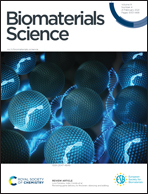4T1 cell membrane fragment reunited PAMAM polymer units disguised as tumor cell clusters for tumor homotypic targeting and anti-metastasis treatment
Abstract
Cell membrane-based nanoparticles have garnered increasing attention owing to their inherent biomimetic properties, such as homotypic targeting, prolong circulation, and immune escaping mechanisms. However, most of these biomimetic nanoparticles appear as an orientated core–shell unit because of the lack of the full utilization and direction control of membranes. Different from those single-unit delivery systems, we reported a multiple-unit nanocluster by randomly reuniting multiple PAMAM polymeric core units into a single nanocluster via simple electrostatic interactions between 4T1 cell membrane fragments and PAMAM. Similar to tumor cell clusters, the doxorubicin (DOX)-loaded nanoclusters (CCNCs) could actively metastasis towards cancer cells after getting access to the systemic circulation due to their specific homotypic targeting ability. In this study, CCNCs showed significantly higher tumor inhibition efficacy in 4T1 tumor-bearing mice compared with that of free DOX and PAMAM@DOX-treated groups. Furthermore, the quantitative analysis showed that the number of pulmonary metastatic nodules remarkably reduced, indicating the potential anti-metastasis effect of CCNCs. Overall, these tumor cell membrane fragment reunited PAMAM polymer units could disguise as tumor cell clusters for encouraging tumor homotypic targeting and anti-metastasis treatment.



 Please wait while we load your content...
Please wait while we load your content...